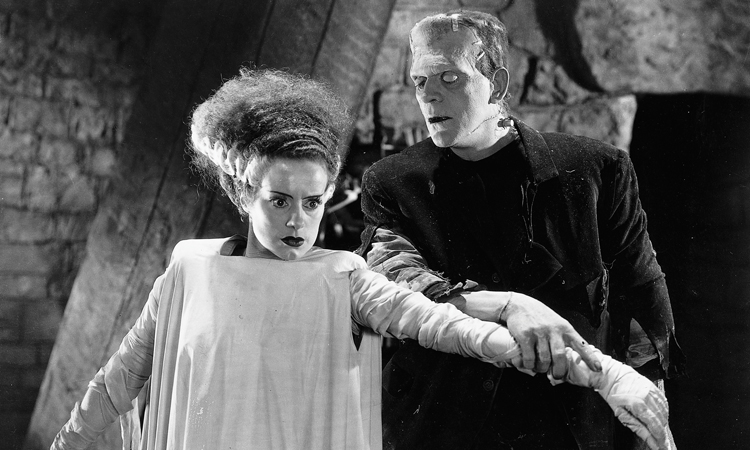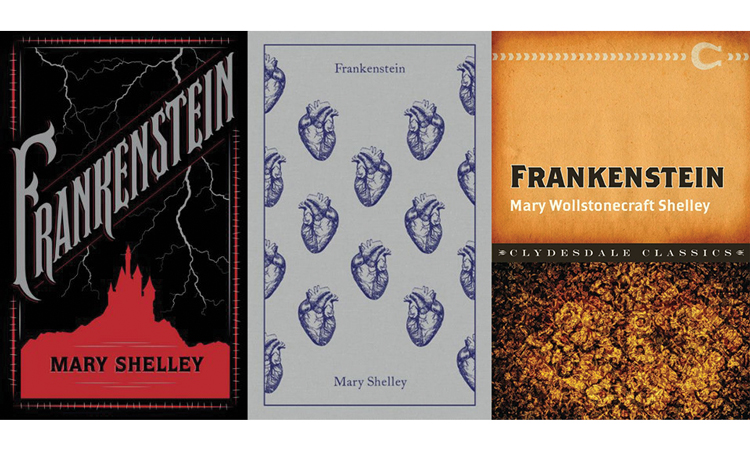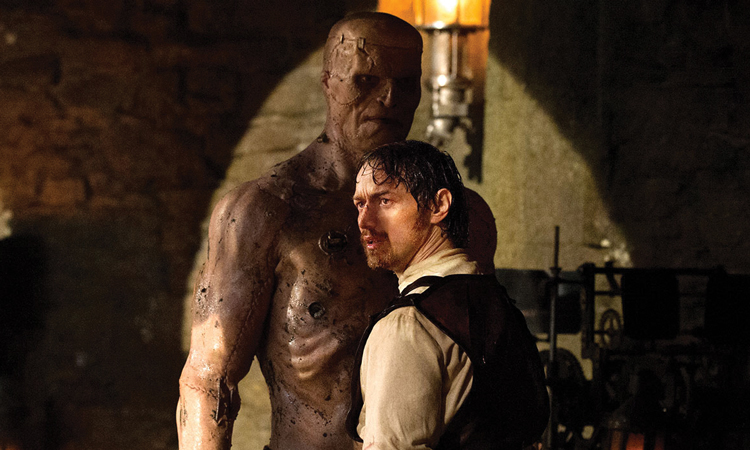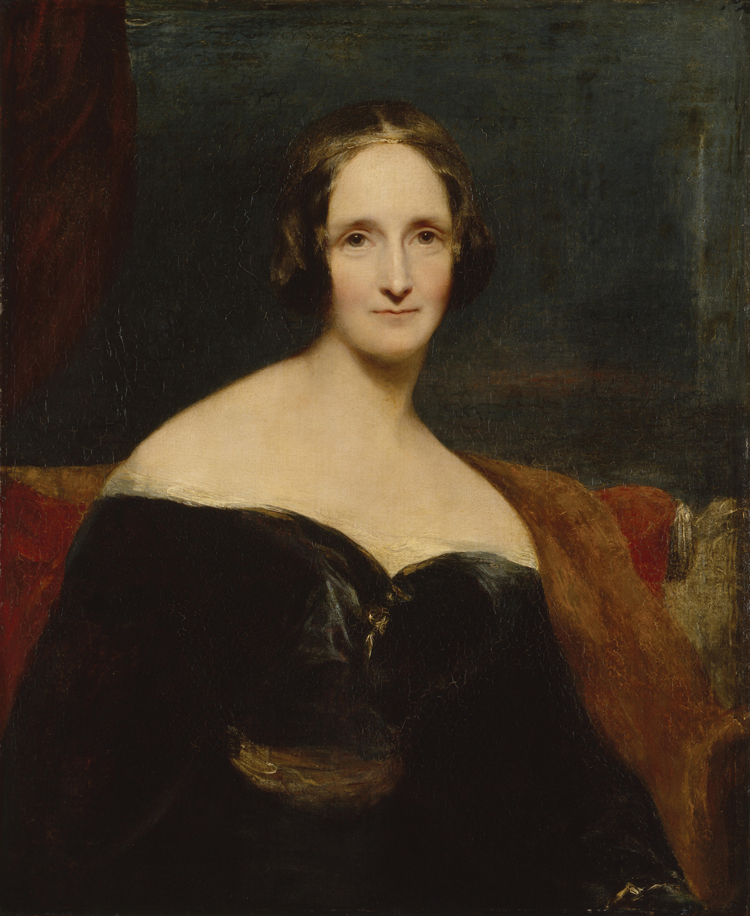Unhappy teenagers often find their way to science fiction, one way or another. It’s hardly surprising that a genre laden with metaphors of loss, loneliness and longing for connection should be attractive to young people struggling to find their place in a world that seems to resent their very existence.
Few such troubled kids have ever conveyed their fears and desires as powerfully – or as significantly – as Mary Shelley. She wrote Frankenstein; or, The Modern Prometheus at the age of 18, having survived unimaginable grief to emerge as one of the greatest writers in the English language. This extraordinary woman used her own tragic experiences as fuel for a novel rich in existential questions and moral conundrums. As the daughter of two eminent philosophers and the wife of poet Percy Bysshe Shelley, circumstance guaranteed her at least a footnote in literary history. Instead, her own genius won her a place in the literary pantheon.
Dr Sorcha Ní Fhlainn is Senior Lecturer in Film Studies and American Studies and founding member of the Manchester Centre for Gothic Studies at Manchester Metropolitan University. She’s well-placed to assess Shelley’s role in birthing a genre still vital to today’s pop culture. “It’s one of those very influential novels that taps into the very primal fears we all have: around birth, around death, around rebirth. Shelley herself had lost a child, and Shelley scholars have found that the torment of this was the psychological drive behind that novel. I think it’s to do with who grants the right to give life and take it and, possibly, to steal it from the gods: that Promethean fire. Who gets to do that? Of course, the novel grapples with the powers of creation – and also the horrors of creation – throughout. The novel is so loaded with those kinds of metaphors that you feel that she was grappling with a very serious emotional heft at the tender age of 17, 18 years old.”

Mary Wollstonecraft Godwin was born in London in 1797. She was brought up by her father, radical philosopher and writer William Godwin, following the death of her mother just a few weeks after her birth. Her childhood was blighted by a sense of guilt at having ‘killed’ Mary Wollstonecraft, a feminist thinker and writer of considerable repute.
A fractious relationship with her stepmother and a complicated bond with her father drove her into the arms of poet-philosopher Percy Bysshe Shelley. Separated from his pregnant wife and estranged from his aristocratic family due to his radical politics, Bysshe Shelley was a kindred spirit. Their passionate affair – allegedly consummated on Mary Wollstonecraft’s grave in St Pancras cemetery – caused scandal and a rift with Mary Godwin’s father.
It was the aftermath of this rift that the couple were trying to flee when they holidayed with Lord Byron and his lover, her stepsister Claire Clairmont, on Lake Geneva. Byron’s physician, John Polidori, was the final member of this talented party. The ghost story competition the friends held would become the stuff of literary legend. Polidori would offer up The Vampyre, the first modern vampire story ever published. Mary Godwin’s contribution was a devastating voyage into emotional torments, reinforced by her knowledge of the then cutting-edge science of galvanism: the movement of muscles in dissected frogs using electrical currents, pioneered in the 1790s by Luigi Galvani.
Ní Fhlainn takes up the story of that strange summer in the Villa Diodati, just a year after the tragic death of Mary Godwin’s baby daughter: “When you think of that night on the lake, in a summer with no sunshine because there was a volcanic eruption the previous year, which had essentially knocked the climate out of whack, you have this really profound, elemental level of disturbance and discord. These influential people are coming together to create their own version of these monsters that will haunt them for the rest of their literary careers and lives. The fact that Mary Shelley outlived them all, and at the same time was possibly the most biologically haunted by her own story and its legacy, is really fascinating, I think.”
Initially unable to think of a story, Godwin found herself inspired to write Frankenstein in the course of one feverish night. Its first edition, published in 1818, was anonymous, and it wasn’t until a second edition in 1823 that its author was identified. The book was a collaboration with Bysshe Shelley, who enthusiastically supported his lover’s work, but the full extent of his involvement remains unclear. Ní Fhlainn cautions against misattribution: “I don’t want to give him too much credit, but Bysshe Shelley really does help her fine-tune her work in a way that it’s ready for publication, as all good writers have good editors.”
Frankenstein tells the story of the brilliant scientist Victor Frankenstein, whose hubristic creation of a man built from human remains leads to the utter destruction of everything he has ever loved. The ‘monster’ is no mere shambling zombie, but a being haunted by a yearning to experience all that human life has to offer. When his attempts to find friendship and love are rebuffed, not least by his appalled ‘father’, the tragic creature exacts terrible retribution. Drawing on the Ovidian myths of Prometheus and Pygmalion, in which humanity is shaped from clay and a lover is conjured from a sculpture, Frankenstein unites timeless fears of social rejection, unnatural power and the existential shock of reproduction. Its impact is as devastating today as it was on its publication.

Ní Fhlainn and her colleagues were thrilled by the reaction to events planned for the book’s bicentenary in 2018. “We had anticipated that there was going to be a celebration within the community, but the extent of it was quite extraordinary. The second you thought that people had kind of acknowledged it and wanted to move on to whatever else was going to be preoccupying the Gothic world, we came back to Frankenstein! I suppose it’s the fact that the metaphor of Frankenstein and the reawakened dead is so potent. It’s not going away anytime soon. It just is a question of to which era you’re applying it. Frankenstein contains so many of the fleshy horrors of undeath. The clean, stripped-down, aristocratic version of that, which would be the vampire, has waxed and waned just as much as the reanimated undead. With Frankenstein, though, the really interesting thing is that it comes back as the horrors of not dying. Death is not the end. That’s both a blessing, if you’re terrified of death, and really horrifying, if you’re enslaved: whether you’re enslaved to corporate capitalism, or you’re enslaved to a person, or a thing, or an idea, or an ideology. So we feel that we’re never going to truly escape the horrors of the present, because we’re trapped in it. It’s a perfect moment for Frankenstein to really be revived.”
She expands on the visceral horror of Mary Shelley’s creation. “The emotional horror of Frankenstein is the isolation. The isolation, the thirst for knowledge, and being aware of his own abject nature. He demands a wife to be made for him because he’s been crushed by the isolation into which he’s been cast off. With zombies, you have the horde mentality, especially with the Romero era, but even if you’re looking at earlier stuff, there’s the idea that the zombie is a metaphor for enslavement and the ideology of capitalist discourse. You look at zombies with a lot of revulsion, whereas in Frankenstein, the revulsion around the monster is mostly from his creator. He doesn’t necessarily provoke that feeling in the earlier parts of the novel when he’s learning to read and things like that, because he’s trying to rise to that challenge and become more humanised and socialised. But when you get to the zombie and the tearing flesh, the virality, the disease, and the lack of being able to express consciousness, that’s when we get the divide. It’s between the horrors of reanimation and being reborn, even if you never asked to be brought back, versus the zombie, who never wanted to leave in the first place and, when they do come back, it’s for destructive ends.”
Frankenstein’s rage-filled ‘child’ is a murderer with a bitter loathing of his selfish and arrogant creator. Why do we find him such a compelling object of sympathy, when we cheerfully watch nameless hordes of undead get mown down by the heroes of countless zombie flicks? “The creature is made monstrous, because his creator is so monstrous. He’s an innocent, and zombies are not innocent, because most of the time they’ve lived their lives and are brought back by supernatural or celestial means, depending on which narrative you follow. There’s something corrupt about the flesh, whereas the creature’s flesh, even though it’s described in the novel as something that’s stretchy and too thin, that doesn’t cover all the viscera and the muscles, is something that is not as abject in terms of its ability to fall apart as that of the zombies.”

It’s a potent work that finds the pressure points in all our psyches – a craving for acceptance, a paradoxical combination of rejection of and craving for familial approval, an equally confounding desire to be both unique and one of the crowd – before pressing down, hard.
As Ní Fhlainn notes, the creature’s response to Frankenstein’s callous rejection is appalling in its brutality and wincingly familiar in its motivation: “Revenge is one of the oldest narratives we have ever had, in any form of storytelling. You’re stripping away everything you can from a person, just as the creature himself felt that he was completely stripped of all kindness or humanity. That idea that you can strip a person down to their most vulnerable, just to remind them that their hubris is what caused this nightmare in the first place. The fact that, at the end, he does wander off into his own existential loneliness takes us back to the beginning of the novel where he feels abandoned.
“It’s a powerful thing in its own way, and I think that suffering is what the creature really wants, to impose that sort of emotional suffering and bring it back to its original roots: the idea that the decisions we make have consequences. Shelley says in the second edition that there was a lot of emotional discord in her writing of the novel. She had at times a very strained relationship with her father. She was doted on by him, but she also felt emotionally at sea because of her mother’s death. I think that undertow does come out in the difference between what you are expected to be and what you are, all those frustrations we can relate to as people, and it’s there in the relationship between the creature and Frankenstein.”
Frankenstein was far from Mary Shelley’s only achievement. After Bysshe Shelley’s death in a boating accident in 1822, she spent the rest of her life writing to support their son while promoting her late husband’s own acclaimed work. Her literary output encompassed novels and travel writing, all of it marked by her unique imagination. She died of a brain tumour in 1851, aged just 53.
Ní Fhlainn deftly summarises her immense significance as a writer and a thinker: “In her own writing, she has in a way birthed the imaginings of modern science fiction. There’s no question about that. She came before all the great male science fiction writers of the 19th Century. I think it’s incredible what she achieved. Early science fiction is rarely kind to women.”
Life itself wasn’t kind to Mary Shelley. Through her writing, she seems to have found a kind of peace with the competing impulses and concerns that caused her so much pain, marked as she was by unwarranted guilt for the death of the mother she never knew and for the brutally abbreviated lives of all but one of her children. In another 200 years, there will still be vulnerable young people who have cause to be grateful that this titan of English literature was brought into the world.
Victor LaValle’s Destroyer is published by BOOM! Studios and Mary Shelley’s Frankenstein is available on Blu-ray from Sony Pictures Home Entertainment.
